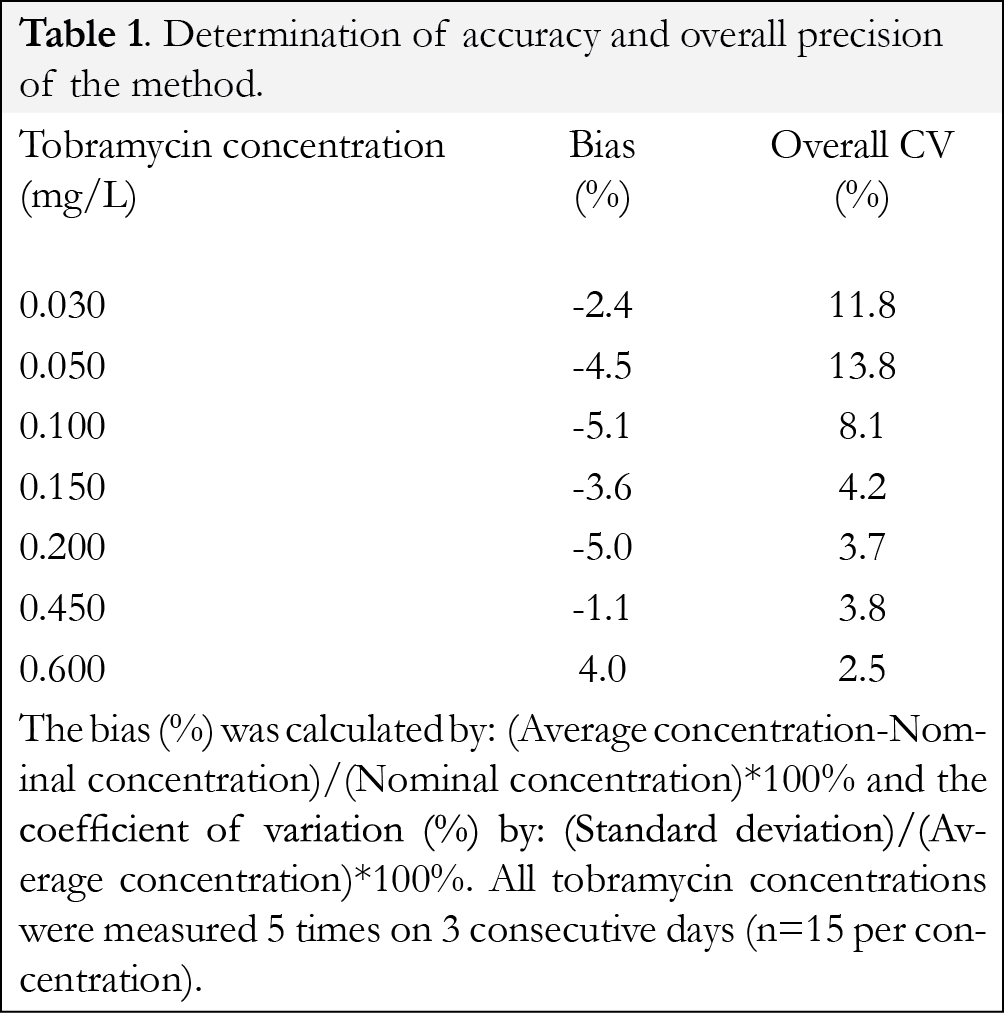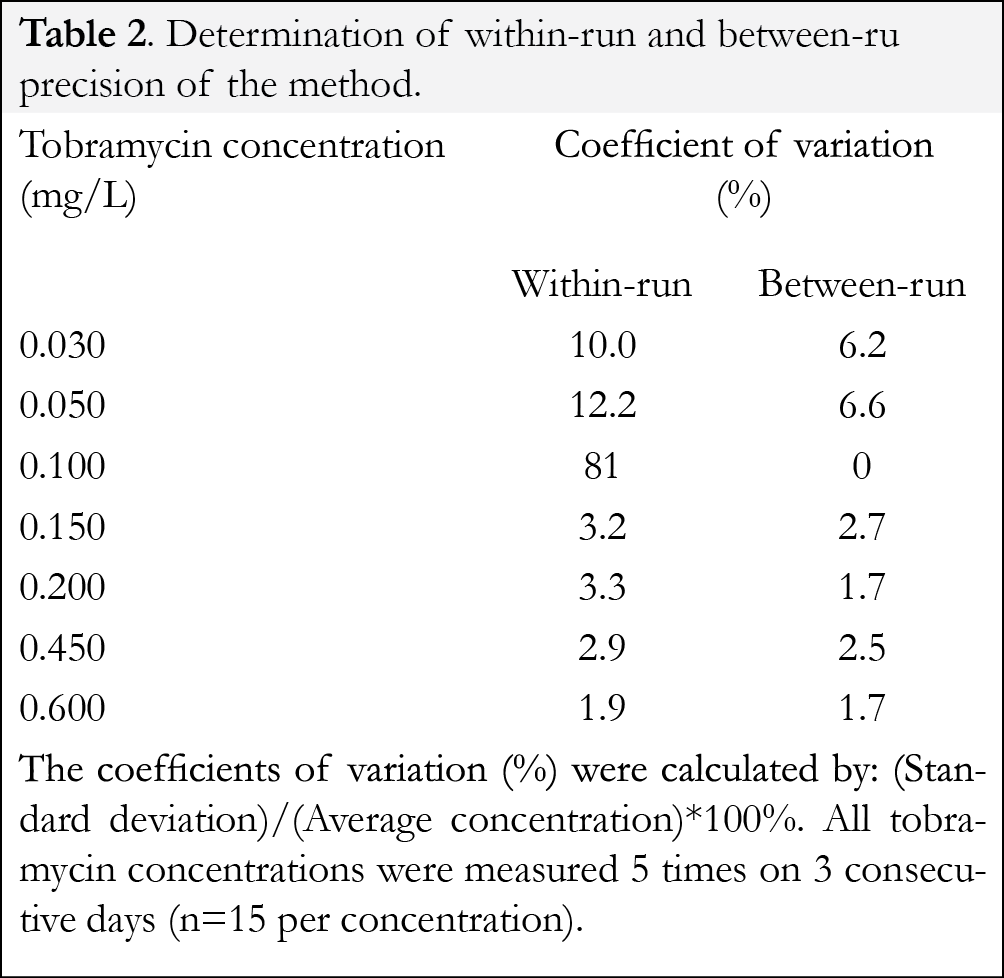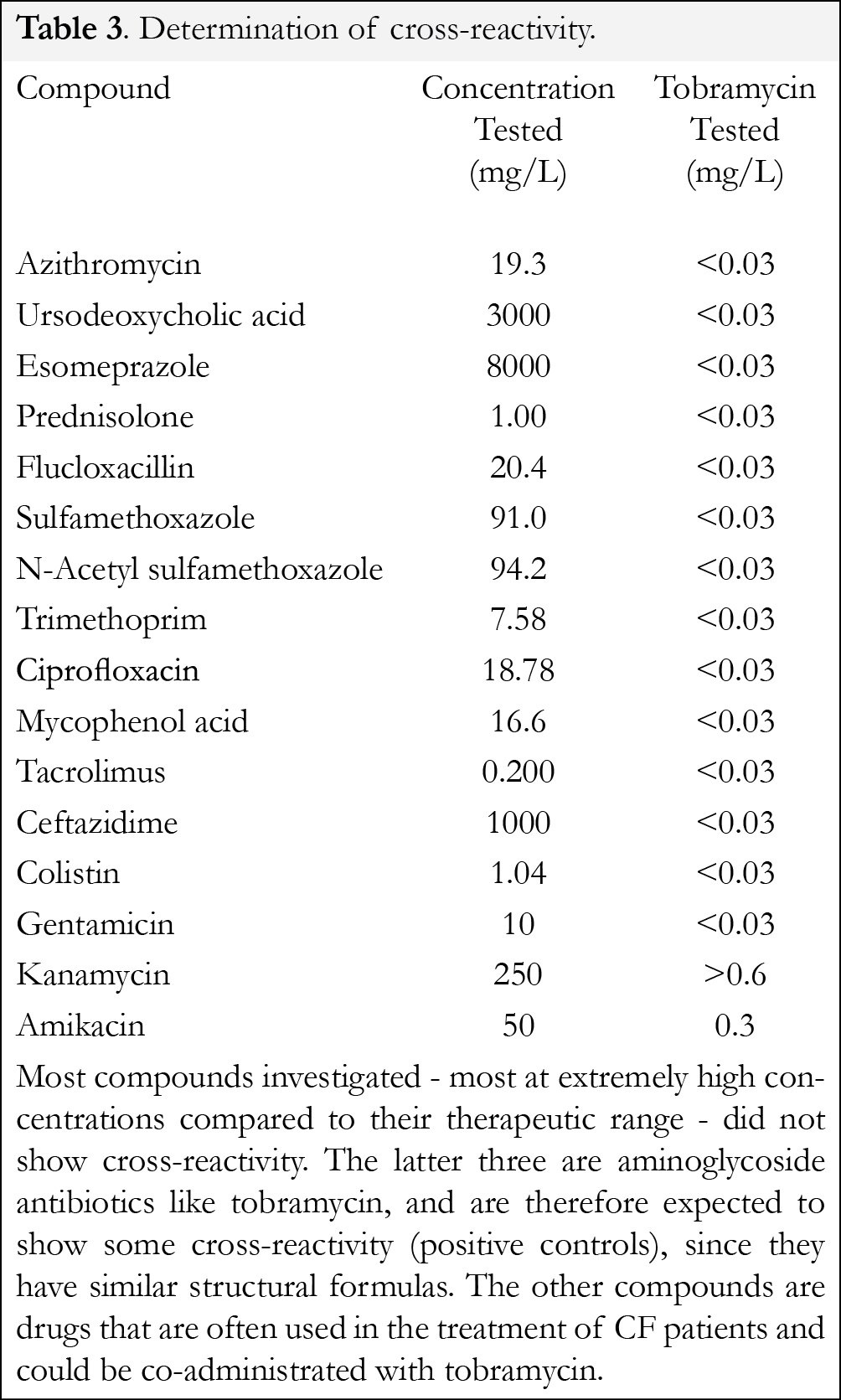Research Article
Optimisation of the sensitivity of an immunoassay analysis for tobramycin in serum
Marcel Hoppentocht1, Onno W. Akkeman2, Albert-Jan Voerman3, Ben Greijdanus3, Daan J. Touw3,4, Jan-Willem C. Alffenaar3,*
1University of Groningen, Department of Pharmaceutical Technology and Biopharmacy, Groningen, The Netherlands.
2University of Groningen,University Medical Center Groningen, Department of Pulmonary Diseases & Tuberculosis.
3University of Groningen, University Medical Center Groningen, Department of Clinical Pharmacy and Pharmacology
4University of Groningen, Department of Pharmacokinetics, Toxicology and Targeting
Vol.1, No. 4, Pages 123-127, doi: 10.17145/jab.15.020. (ISSN 2405-710X). Download PDF
Correspondence
†Correspondence: University of Groningen, University Medical Center Groningen, Department of Clinical Pharmacy and Pharmacology, Clinical Pharmaceutical and Toxicological Laboratory, PO Box 30.001, 9700 RB Groningen, The Netherlands. Phone: +31 503614070; Fax: +31 503614087. E-mail: This email address is being protected from spambots. You need JavaScript enabled to view it.
Open Access and Copyright
©2015 Hoppentocht M et al. This article is an open access article distributed under the terms of the Creative Commons Attribution License (CC-BY) which permits any use, distribution, and reproduction in any medium, provided the original author(s) and source are credited.
Abstract
Tobramycin is an aminoglycoside antimicrobial drug frequently used in anti-pseudomonal therapy in cystic fibrosis and non-cystic fibrosis bronchiectasis patients. Therapeutic drug monitoring is routinely performed to increase efficacy and reduce the chance of toxicity. The most frequently used method to quantify tobramycin in serum or plasma is with an immunoassay method. However, immunoassays lack sensitivity to evaluate the lower concentrations of tobramycin for pharmacokinetic studies of for instance inhaled tobramycin. The aim of this study was to optimise the Syva® Emit® 2000 Tobramycin Assay combined with the ARCHITECT c8000. This adapted method was validated for accuracy and precision, having within-run, between-run variation. The adapted tobramycin immunoassay method has a linear range of 0.03 to 0.6 mg/L, which is comparable to liquid chromatography-mass spectrometry methods. The immunoassay method was validated with representative samples and has been implemented in routine analysis.
Keywords: ARCHITECT, tobramycin, immunoassay, EMIT.
Introduction
Tobramycin is an aminoglycoside antimicrobial drug and is the cornerstone in anti-Pseudomonas aeruginosa (Psa) therapy in Cystic Fibrosis (CF) and non-CF bronchiectasis patients [1,2]. Furthermore, it is frequently used to treat severe infections caused by tobramycin sensitive micro-organisms in hospitalised patients [3]. With the introduction of the TOBI® Podhaler™ (dry powder inhaler with tobramycin), pulmonary administraion of tobramycin is likely to become even more popular in the treatment of CF and non-CF bronchiectasis patients colonised with Psa, since dry powder inhalation is much more user-friendly [4]. Tobramycin therapy is optimised by drug monitoring but the compound lacks a chromophore group and it is, therefore, very challenging to determine its concentration in serum or plasma by standard high-performance liquid chromatography (HPLC) with UV detection. A frequently used method to quantify tobramycin in serum or plasma is with an immunoassay method. However, a disadvantage of immunoassays for tobramycin is the limit of detection of 0.2 mg/L. Immunoassay methods are suitable to measure trough and peak concentrations of intravenously administered tobramycin, but they lack the sensitivity to evaluate lower concentrations of tobramycin for pharmacokinetic studies of, for instance, inhaled (dry powder) tobramycin. Therefore, analytical methods using liquid chromatography-mass spectrometry (LC-MS) and other more complex LC methods have been developed. These methods often need derivatisation of the samples before tobramycin can be detected [5–9], this is time-consuming and expensive. Furthermore, the analytical robustness of these methods at lower limit of quantification (LLOQ) is limited. A more promising approach could be adaptation of existing immunoassay methods. Immunoassays are widely used, relatively cheap and easy to perform [10]. Previously, the sensitivity of a tobramycin immunoassay has successfully been increased [11]. However, the TDxFLx platform used for this method has been discontinued. Therefore, the aim of this study was to optimise the Syva® Emit® 2000 Tobramycin Assay combined with the ARCHITECT c8000, to be able to quantify concentrations 10 times lower than 0.2 mg/L suitable for use in, for instance, clinical studies with inhaled dry powder tobramycin.
Materials and methods
Materials
The Syva® Emit® 2000 Tobramycin Assay and Syva® Emit® 2000 Calibrators were purchased from Siemens (Siemens Nederland NV–Health sector, Den Haag, the Netherlands). All chemicals used were of analytical grade. Human serum was made available according to standard hospital procedures. Only plastic pipette tips, sample tubes and analyser reagent containers were used to prevent tobramycin adsorption to glass surfaces [12].
Methods
Enzyme multiplied immunoassay technique
The analyser used during this research is the ARCHITECT c8000 (Abbott Diagnostics, Chicago, USA). The Syva® Emit® 2000 Tobramycin Assay is a homogenous enzyme immunoassay technique. The tobramycin concentration in a sample can be measured in terms of enzyme activity. Active enzyme converts oxidised NAD to NADH, resulting in an absorbance change that is measured spectrophotometrically. The Syva® Emit® 2000 Tobramycin Assay and Syva® Emit® 2000 Calibrators were used as described in the package insert. The assay was calibrated using three calibration points in the lowest concentration range and all routine measurements were performed as single measurements.
Optimisation of the limit of quantification
The higher limit of quantification (HLOQ) and LLOQ are affected by the coefficient of variation (CV) of the immunoassay. The HLOQ can easily be circumvented by dilution of the samples. However, the LLOQ is primarily determined by the sensitivity of the method and, therefore, harder to reduce. To lower the LLOQ the main parameter to be optimised was the sample volume. The sample volume was increased from the standard 3 µL to 18 µL to increase the total amount of tobramycin to be measured in the sample and thus, the sensitivity of the method. Accordingly the HLOQ is expected to be lower. By varying the sample volume, the measuring range of the Syva® Emit® 2000 Tobramycin Assay, in which it can accurately quantitate tobramycin concentrations, can be significantly increased. To demonstrate that increasing the sample volume does not have a profound effect on the sensitivity of the assay, the method was extensively validated.
Method validation
This method was validated for accuracy and precision [13,14]. For the accuracy the bias should not exceed 15%, or should not exceed 20% for LLOQ determination. For the precision the CV should not exceed 15%, except for the LLOQ, for which the CV should not exceed 20%. Precision was assessed by evaluation of within-run and between-run CVs. For determination of the LLOQ and for QC the following concentrations of tobramycin in human serum were prepared: 0.03, 0.05, 0.10, 0.15 and 0.20 mg/L. For determination of the range for this method the additional following concentrations of tobramycin in human serum were prepared: 0.45 and 0.6 mg/L. As a measure for the increased sensitivity, the accuracy and the precision of the assay, the bias and within-run, between-run and overall CV were determined. All levels (LLOQ and QCs) were measured 5 times a day for 3 consecutive days. The total replicate number (n) for each level is therefore 15. Calibration was done by using two commercial calibrators at the lowest level (0.0 mg/L and 0.6 mg/L). A third intermediate calibration-level was created by the Architect-analyser by means of a dilution.
Cross-reactivity
Despite the sensitivity of immunoassay methods, cross-reactivity with endogenous and exogenous compounds (e.g. drugs) may occur. Therefore, the cross-reactivity of this method with different drugs in human serum was investigated. These drugs were: azithromycin, ursodeoxycholic acid, esomeprazole, prednisolone, flucloxacillin, sulfamethoxazole, n-acetyl sulfamethoxazole, trimethoprim, ciprofloxacin, mycophenolic acid, tacrolimus, ceftazidime, colistin, gentamicin, kanamycin and amikacin. The latter three are aminoglycoside antibiotics like tobramycin, and are therefore expected to show some cross-reactivity (positive controls), since they have similar structural formulas. The other compounds are drugs that are often used in the treatment of CF patients and could be co-administrated with tobramycin.
Results
Lower limit of quantification
The bias and the CVs were determined with tobramycin concentrations between 0.03 and 0.6 mg/L as a measure for the increased sensitivity of the method. After measuring the LLQQ (0.03 mg/L) and the QCs (0.03 – 0.05 – 0.10 – 015 and 0.20 mg/L) in a frequency of 5 times a day for 3 days (n=15) the bias and CVs were calculated. Table 1 shows that the bias is within the defined limits of 15% [13] and that the bias and CVs for the QCs are within the defined specification of 20% [14]. The within-run CV varied from 1.9% – 12.2% and between-run from 0% – 6.6% and, therefore, the requirements for accuracy and precision (Table 2) were met.
Calibration curve
To investigate and demonstrate the applicability of the analytical procedure, the range of the calibration curve between 0 and 0.6 mg/L was investigated with in-house prepared QC samples (Figure 1). The theoretical (calculated) value was plotted against the measured value and Figure 1 shows that the measured values correlate with the prepared concentrations.
Cross-reactivity
A range of compounds was investigated for drug interference (Table 3). As expected, kanamycin and amikacin showed cross-reactivity with the Syva® Emit® 2000 Tobramycin Assay. Tobramycin, kanamycin and amikacin have very similar structural formulas and this causes cross-reactivity [15]. Gentamicin – also an aminoglycoside antibiotic–did not show any cross-reactivity. A possible explanation for this is that the other three are more structurally related since they are produced by bacteria from the Streptomyces genus, while gentamicin is produced by bacteria from the Micromonospora genus. With all other compounds investigated no cross-reactivity was observed.
Discussion
According to the specifications of the Syva® Emit® 2000 Tobramycin Assay it can accurately quantitate tobramycin concentrations in human serum or plasma containing 0.2-10 mg/L tobramycin (without dilution). By increasing the sample volume we were able to increase the sensitivity of this immunoassay. This validated method has already been used for serum-concentration analysis of tobramycin in a pilot study with 8 non-CF bronchiectasis patients (manuscript under review). In this study the participants received tobramycin, as the free base, administered with a new disposable dry powder inhaler called the Cyclops [16]. After pulmonary administration of relatively low tobramycin doses, the serum-concentrations are too low for quantification with standard tobramycin immunoassay methods. We chose this approach, because immunoassays are generally faster and easier to perform than HPLC based analytical procedures, which suffer from the need for sample derivatisation before tobramycin can be analysed with fluorescence, electrochemical or UV detectors. LC-MS methods have also been developed, but these are time-consuming and expensive too. Furthermore, the analytical robustness of these methods at lower LLOQ is limited, while equipment to perform immunoassays (like the ARCHITECT c8000) are more widespread and easier to operate. Moreover, the currently used analysers (like the ARCHITECT c8000) offer more freedom with regard to varying the settings than older systems, this opens the way to new applications like the method described in this paper.
This study presents a validated, simple and rapid analytical method using an immunoassay for the quantification of tobramycin in human serum at a concentration level approximately 10 times lower compared to the standard procedure. This method was validated for accuracy and precision [12,13], having within-run, between-run and overall CVs lower than 20% for the LLOQ and lower than 15% for other QC levels (Tables 1 and 2). The method has a range of 0.03 to 0.6 mg/L, which was comparable to LC-MS/MS methods used in earlier studies [5,6].
Since kanamycin and amikacin cross-react with the tobramycin assay, this assay cannot be used to accurately quantitate tobramycin serum (or plasma) levels in patients receiving any of these drugs in combination with tobramycin. Considering the different indications of these drugs co-administration is unlikely and could be checked for by the Lab. The package insert from Siemens states that only very high concentrations of gentamicin (100 mg/L) could affect the results. Despite the increased sensitivity of the procedure, analysing a sample with 10 mg/L of gentamicin (within the therapeutic range) did not show any interference with the adapted assay. All other compounds investigated - most at extremely high concentrations compared to their therapeutic range - did not show cross-reactivity either (Table 3). If these compounds do not interfere with the assay at very high concentrations, cross-reactivity of these compounds in lower concentrations is also ruled out.
The newly validated immunoassay method enables the quantification of low concentrations of tobramycin in serum. The adapted method with increased sample volume is much more sensitive than the specifications of the Syva® Emit® 2000 Tobramycin Assay with standard sample volume, and the sensitivity is comparable to more time-consuming LC-MS/MS methods presented in the literature.
Conclusions
With the adapted method a rapid immunoassay became available that enables quantification of tobramycin concentrations as low as 0.03 mg/L and up to 0.6 mg/L. The method was validated with representative samples and already showed its utility in routine analysis.
References
1. Heijerman H, Westerman E, Conway S et al. Inhaled medication and inhalation devices for lung disease in patients with cystic fibrosis: a European consensus. J. Cyst. Fibros. 8, 295–315 (2009). [CrossRef]
2. Pappalettera M, Aliberti S, Castellotti P et al. Bronchiectasis: an update. Clin. Respir. J. 3, 126–134 (2009). [CrossRef]
3. Kotra LP, Haddad J, Mobashery S. Aminoglycosides: Perspectives on Mechanisms of Action and Resistance and Strategies to Counter Resistance. Antimicrob. Agents Chemother. 44, 3249–3256 (2000). [CrossRef]
4. Geller DE, Weers J, Heuerding S. Development of an inhaled dry-powder formulation of tobramycin using PulmoSphereTM technology. J. Aerosol Med. Pulm. D. 24, 175–182 (2011). [CrossRef]
5. Keevil BG, Lockhart SJ, Cooper DP. Determination of tobramycin in serum using liquid chromatography–tandem mass spectrometry and comparison with a fluorescence polarisation assay. J. Chromatogr. B 794, 329–335 (2003). [CrossRef]
6. Attema-de Jonge ME, Bekkers JM, Oudemans-van Straaten HM et al. Simple and sensitive method for quantification of low tobramycin concentrations in human plasma using HPLC–MS/MS. J. Chromatogr. B 862, 257–262 (2008). [CrossRef]
7. Megoulas N, Koupparis M. Development and validation of a novel HPLC/ELSD method for the direct determination of tobramycin in pharmaceuticals, plasma, and urine. Anal. Bioanal. Chem. 382, 290–296 (2005). [CrossRef]
8. Feng CH, Lin SJ, Wu HL et al. Trace analysis of tobramycin in human plasma by derivatization and high-performance liquid chromatography with ultraviolet detection. J. Chromatogr. B 780, 349–354 (2002). [CrossRef]
9. Lu CY, Feng CH. Micro-scale analysis of aminoglycoside antibiotics in human plasma by capillary liquid chromatography and nanospray tandem mass spectrometry with column switching. J. Chromatogr. A 1156, 249–253 (2007). [CrossRef]
10. Bock JL. The New Era of Automated Immunoassay. Am. J. Clin. Pathol. 113, 628–646 (2000). [CrossRef]
11. Touw DJ, de Graaf AI, de Goede P. Evaluation of a Fluorescence Polarographic Immunoassay with Increased Sensitivity for Measurement of Low Concentrations of Tobramycin in Serum. Ther. Drug Monit. 18, 189–193 (1996). [CrossRef]
12. Josephson L, Houle P, Haggerty M. Stability of dilute solutions of gentamicin and tobramycin. Clin. Chem. 25, 298–300 (1979). [CrossRef]
13. European Medicines Agency & Committee for Medicinal Products for Human Use (CHMP). Guideline on bioanalytical method validation. (2011). at http://www.ema.europa.eu/docs/en_GB/document_library/Scientific_guideline/2011/08/WC500109686.pdf
14. U.S. Department of Health and Human Services & Food and Drug Administration. Guidance for Industry Bioanalytical Method Validation Guidance for Industry Bioanalytical Method Validation. (2001). at http://www.fda.gov/downloads/Drugs/Guidances/ucm070107.pdf
15. Vakulenko SB, Mobashery S. Versatility of aminoglycosides and prospects for their future. Clin. Microbiol. Rev. 16, 430–450 (2003). [CrossRef]
16. Hoppentocht M, Akkerman OW, Hagedoorn P et al. The Cyclops for pulmonary delivery of aminoglycosides; a new member of the TwincerTM family. Eur. J. Pharm. Biopharm. 90, 8–15 (2015). [CrossRef]
All site content, except where otherwise noted, is licensed under a Creative Commons Attribution 4.0 License.
![]()





 Open Access Article
Open Access Article Peer-reviewed Article
Peer-reviewed Article Creative Commons Attribution 4.0 License
Creative Commons Attribution 4.0 License 